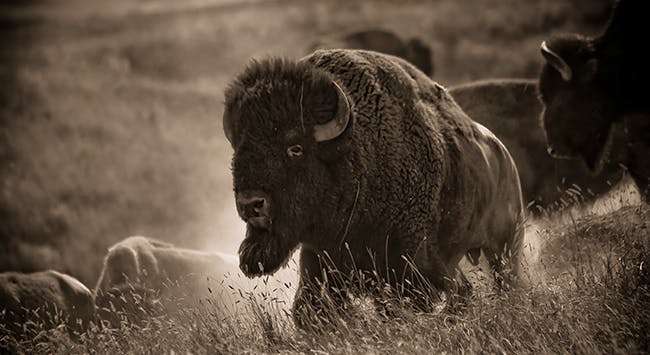The year was 1998, and things were not going well for the Yellowstone bison. Defenders of Wildlife and our allies were locked in a struggle to turn around a terrible proposal…one that would trap bison inside Yellowstone National Park’s politically-defined boundary for a very long time. For bison – a species that has roamed and migrated over America’s great plains for centuries – this plan blocking their seasonal migration was not only senseless, it was impractical. That left it to Defenders and our allies, which included most of Montana’s conservation groups, to present an alternative to the State of Montana and the National Park Service.
As I look at a faded copy on my desk, “The Citizen’s Plan to Save Yellowstone Buffalo” was a remarkably forward-looking plan. Coauthored by multiple conservation organizations, including Defenders, it called for an area outside the park where bison could move freely, as well as a plan to restore bison on public and tribal lands. The agencies’ plan on the other hand, would make a permanent “management strategy” out of the routine capturing and killing of bison. It capped the bison allowed to remain in the park at an unreasonably low number, and refused to embrace any opportunity to allow bison to roam beyond the park borders. All of this was supported, in great part, by the claim that bison posed a threat of spreading a disease called “brucellosis” to cattle – even though there had never been a single case of transmission of brucellosis from bison to livestock in the wild.
(story continues below)

Sadly, the agencies’ restrictive plan to cap bison populations inside Yellowstone and kill any that wandered outside the park was adopted. And so, for the past 18 years, bison have languished in a kind of management hell. As predicted, the arbitrary population limits have resulted in thousands of bison sent to slaughterhouses. Thousands more have been brutally driven from Montana’s public lands back into the park, chased by cowboys, helicopters, and ATVs. The social conflict has been unrelenting, resulting in numerous court cases, petitions, and contentious legislative hearings.
That is, until recently.
In December, Montana Governor Steve Bullock issued a long-overdue rule that would at last permit bison to roam free year-round (with some restrictions) on more than 400,000 acres outside the park in Montana. The rule recognizes that bison are wildlife (a fact the agencies disagreed on), and that management of wildlife is a shared responsibility between the park and the state. Moreover, the rule implies that seasonal bison migration is a natural process – one that all the anti-bison legislators in Montana cannot make disappear through passage of bad laws and drawing of arbitrary political boundaries.
With luck, as this spring approaches, bison will be able to seek the new grass at the lower elevations outside the park. And, they’ll be able to make their way back into the park on their own schedule as the summer grasses become available with the melting snow.
In addition to the new rule giving bison more room to roam outside of Yellowstone, NPS has announced a second proposal that, if passed, will give many Yellowstone bison a reprieve from the slaughterhouse. Under the new National Park Service proposal, it will be possible to send some bison to tribal and public lands for conservation, instead of sending them to slaughter. The park’s preferred alternative would test and relocate healthy bison to Fort Peck Indian Reservation in northeastern Montana. There, they would be kept in a surveillance pasture until determined to be disease free. Then they could be added to the Fort Peck Reservation cultural bison herd, or sent to other locations to start or support similar bison conservation efforts.
(story continues below)

Make no mistake, this new policy is the result of tremendous investment in years of scientific research that convinced health authorities that disease-free bison could be identified and used for restoration. While this proposal won’t save all bison from slaughter, it’s an incredible step forward. When Yellowstone National Park finalizes its plan, every bison that tests free of disease could be relocated, helping to seed conservation herds of wild Yellowstone bison across Montana and elsewhere in North America. Every bison that walks out alive from this process is an improvement over the waste and tragedy of the past.
Yellowstone National Park officials want to hear what the public thinks about this restoration alternative, and is taking comments until February 18. We’re urging everyone who wants to save Yellowstone bison to support this plan.
This story is about perseverance. Despite setbacks and delays, Defenders and the many tribes and conservation organizations we have worked with over the years never gave up and have not rested on the bison issue in the past two decades. We won’t let go of a good idea when it is the right thing to do where wildlife are concerned. Rest assured that we will continue to look for ways to make the Governor’s plan work and give Yellowstone bison a chance to thrive. We’re in it for the long haul.



